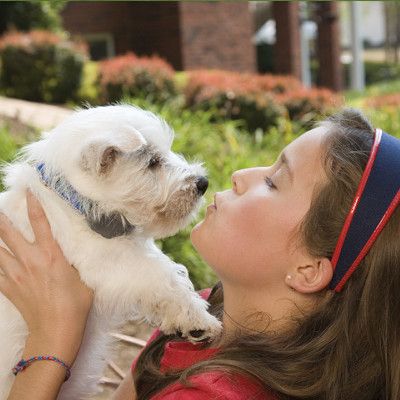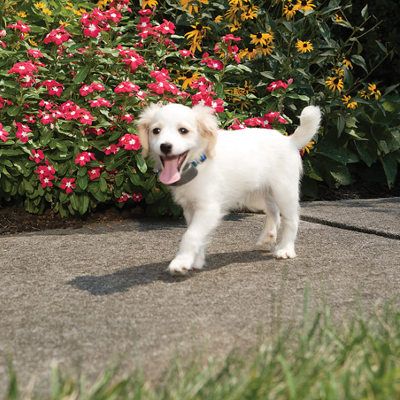 I have been a dog trainer/behavior consultant for 20+ years and worked with thousands of puppies. To me, the single most important factor in choosing a puppy is choosing a breeder or rescue that has interacted with the puppies and begun the socialization process.
I have been a dog trainer/behavior consultant for 20+ years and worked with thousands of puppies. To me, the single most important factor in choosing a puppy is choosing a breeder or rescue that has interacted with the puppies and begun the socialization process.
I would much rather purchase from a breeder who has the puppies in her house because those puppies have a head start by being exposed to the sounds, smells, and activities that occur there vs. a puppy that lives in a kennel who has not experienced these things.
Before we go any further, let's define terms. "Socializing" is animal to animal, two living beings. "Habituation" is getting used to something. However, the terms "socializing" and "habituating" have been lumped together under the term "socialization" for such a long time that it's difficult for many of us to separate them now - we are using the terms colloquially even though our use is technically incorrect.
So, for our purposes, the definition of "Socialization" is a puppy's being comfortable around anything new before he is 16 weeks old - including humans, other animals, and the sights, smells, sounds, and locations of everyday life. It has 3 basic components:
- Primary socialization of dogs with dogs
- Secondary socialization of dogs with humans and other animals
- Habituation to objects and events in his environment
 When a puppy is born, he does not know that he is a dog. He must learn how to interact with other dogs (primary socialization). He must also learn how to interact with humans and other animals (secondary socialization) and also to be comfortable in his environment (habituation).
When a puppy is born, he does not know that he is a dog. He must learn how to interact with other dogs (primary socialization). He must also learn how to interact with humans and other animals (secondary socialization) and also to be comfortable in his environment (habituation).
Keeping in mind that socialization is dog to dog and then dog to people, the bulk of what people do as breeders and owners is habituation and environmental enrichment.
Environmental enrichment and habituation should begin around Week 3 because
- This is when puppies' eyes and ears open and they begin to learn about their surroundings.
- The fear response has not developed yet so they are not afraid of novel things.
- They begin to play with each other.
- They begin to learn about how to be a dog. THIS is socializing!
 Environmental Enrichment
Environmental Enrichment
There are generally 5 categories of environmental enrichment that the breeder and then owner introduce which offer both physical and mental tests that challenge the puppy and expose him to novel encounters that help him cope in later life.
Use your best judgment as to when to begin with each puppy. Even though they were born on the same day and came from the same dam (mother), they may not have the same temperament and may not be the same developmentally.
Food - feeding different foods in different receptacles
Novelty - changing or moving the whelping pen, introducing items into the whelping area, and taking the puppy on excursions out of the whelping area
Sensory Sound
- Introduce a variety of sounds by naturally occurring sounds in the house (such as doors slamming and keys dropping).
- Purchase a DVD containing sounds from trains to boat whistles to fireworks.
- Make sure the puppy gets to hear as many sounds as possible.
- Introduce different noises starting with the puppies hearing them in a group and then individually.
Sight
- Change the light levels by turning one and then several lights on and off.
- Drag a toy or cloth from puppies both inside and outside the box so the puppies can see movement.
- Put plastic bottles and a few toys of different shapes and sizes in the whelping box away from the sleeping area.
- These toys should have different shapes, colors, and textures, and be sure that the puppies cannot swallow them or any part of them.
 Smell
Smell
- Introduce new smells - herbs, flowers - by placing these in the nest room.
- Use towels to introduce other scents. As an example, leave a towel in your veterinarian's office to soak up those smells and then hang it in the nest area.
Touch
- Examine each puppy as a vet would examine a dog, checking and touching all over his body.
- Teach each puppy to accept being restrained.
- Introduce visitors, both men and women, who should sit on the floor, so the puppies can approach them at their own pace.
- Each person can pick up, hold, and talk to each puppy and touch them all over their bodies.
Go gently! Remember that each puppy is an individual, and what one puppy is ready for at 4 weeks, another puppy may not be ready for until 6 weeks.
This is just a beginning. There are hundreds of additional suggestions in my Puppy Socialization book. And just use your imagination on how to introduce your puppies to new things so that they will turn out to be well-adjusted dogs.






